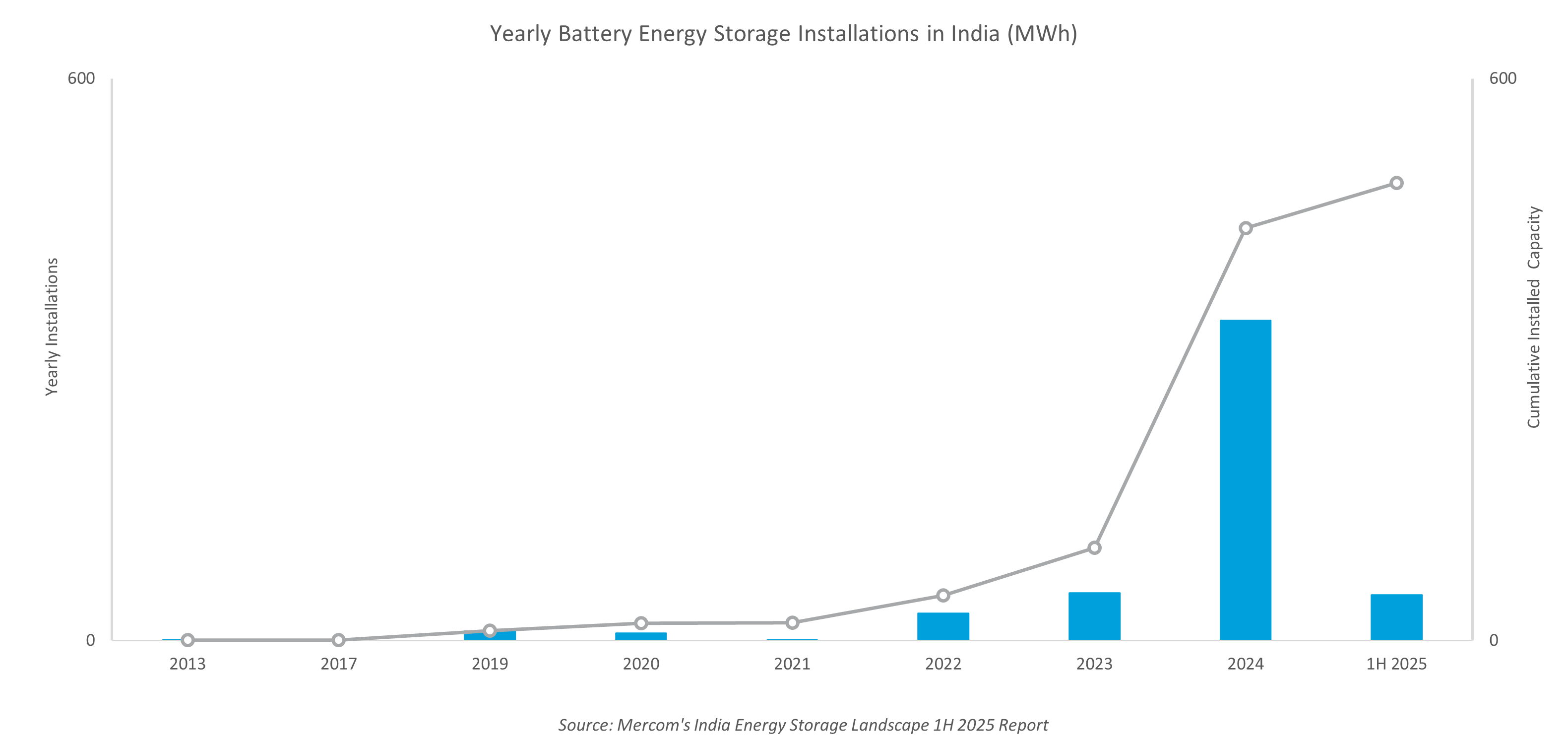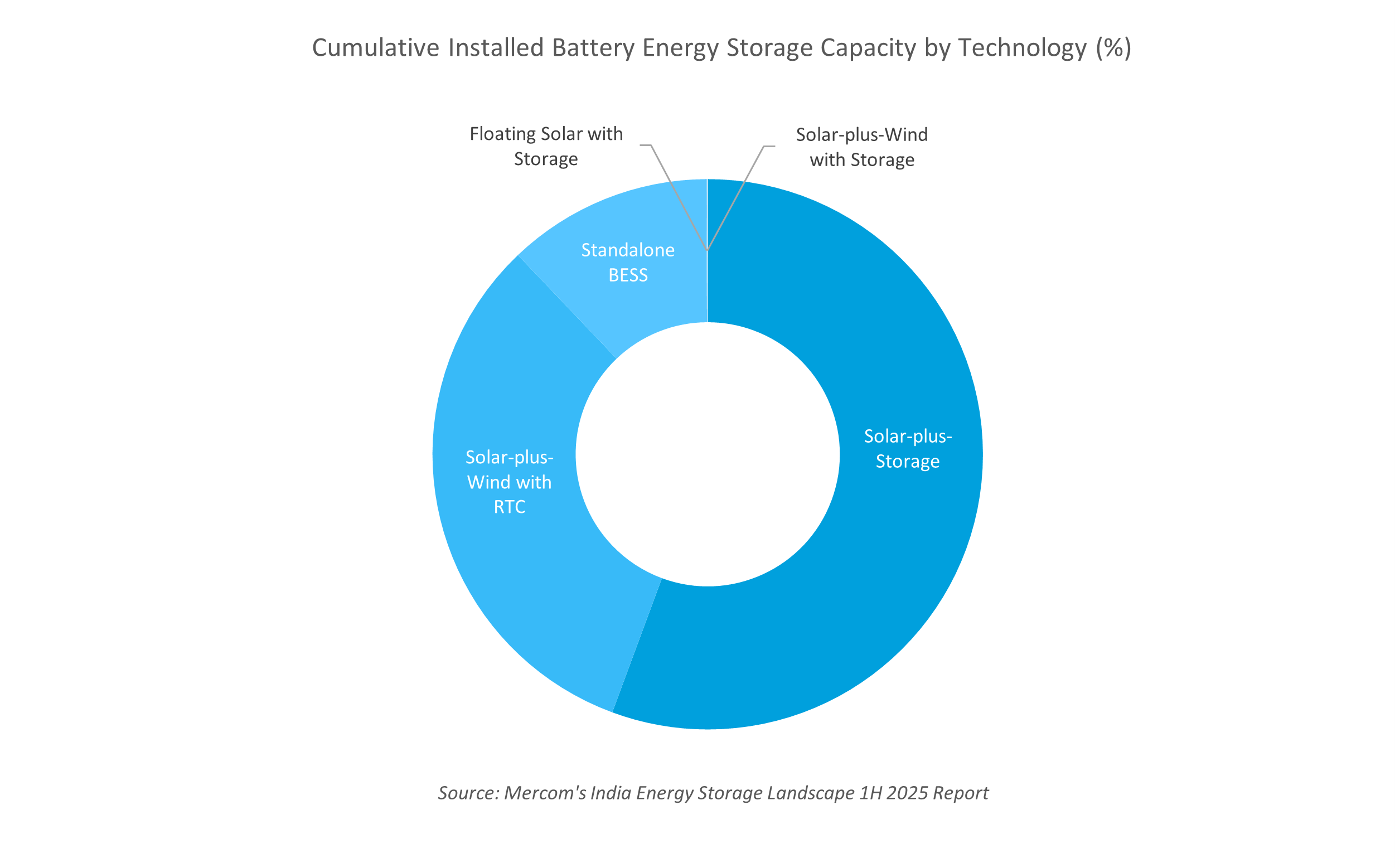India Added 48.4 MWh of Energy Storage Capacity in 1H 2025
The total installed energy storage was 490 MWh by the end of June 2025
October 7, 2025
Follow Mercom India on WhatsApp for exclusive updates on clean energy news and insights
India added 48.4 MWh of energy storage capacity in the first half (1H) of 2025, a 74% decline from 186 MWh added in the same period last year, according to the newly released India’s Energy Storage Landscape 1H 2025 Report by Mercom India Research.
India’s cumulative installed energy storage capacity reached 490 MWh by the end of June 2025.
“Lower installation numbers in the first half are not a setback – they represent a pause before the next phase of strong growth,” said Raj Prabhu, CEO at Mercom Capital Group. “Strong policy support through the ISTS charges waiver extension and the expanded VGF program is laying the foundation for rapid deployment. Investor confidence is rising, tender activity is accelerating, and the sector is now positioned for sustained growth. These measures will drive cost stability, mobilize new capital, and solidify energy storage as a cornerstone of India’s clean energy transition.”
Solar-plus-storage systems accounted for nearly 56% of India’s cumulative installed capacity. This was followed by more than 32% from solar-plus-wind projects with round-the-clock capability, and over 12% from standalone battery energy storage systems. The remaining share came from floating solar with storage, and solar-plus-wind projects with storage capabilities.
India also has an operational pumped storage capacity of 5 GW as of the time of the report’s publication.
Strong policy support, including the second tranche of the viability gap funding program and the Central Electricity Authority’s mandate to include co-located storage in all solar tenders with a minimum duration of two hours, equal to 10% of solar capacity, is helping to accelerate the adoption of energy storage across the country.
As of June 2025, Karnataka led with 33% of India’s cumulative installed energy storage capacity, followed by Chhattisgarh at 24% and Gujarat at 16%.
Priya Sanjay, Managing Director at Mercom India, noted that states with high renewable penetration are already feeling the strain on the grid. In places like Karnataka, Rajasthan, Gujarat, and Kerala, rooftop solar installations bring sharp swings, over-injection during solar hours, and later spikes in demand, which make grid management challenging. DISCOMs are dealing with these grid-integration issues every day, with storage helping smooth those curves to some extent.
As of June 2025, India had about 13.7 GWh of standalone battery storage under development. It also had approximately 3.9 GWh of solar plus wind with storage, around 3.2 GWh of solar plus storage, more than 1.4 GWh of round-the-clock solar plus wind with storage, and 415 MWh of other renewable energy projects with storage at various stages.
Gujarat had the largest pipeline of standalone battery storage capacity, followed by Maharashtra and Rajasthan. Supportive policies in these states, along with annual energy storage obligations through financial year 2030, were driving demand.
Pumped storage remained the largest segment, with more than 81 GW in the pipeline, including approximately 12.4 GW under construction, about 3.3 GW in pre-construction, over 2.4 GW under examination after detailed project report submission, and nearly 63 GW in the survey and investigation phase.
In 1H 2025, government agencies issued more than 16 GW of energy storage tenders and auctioned more than 9 GW of projects, with or without associated renewable energy capacity. Solar plus storage tenders gained strong momentum, rising about 381% YoY compared to 1H 2024.
“Energy storage makes economic sense for some users; over time, it will make sense for many more. The immediate, practical applications include peak shaving, mitigating power cuts, and supporting grid integration where renewables are already high,” Sanjay said.
Mercom India’s Energy Storage Landscape 1H 2025 report is 102 pages long and covers all facets of India’s energy storage projects. For the complete report, visit: https://www.mercomindia.com/product/india-energy-storage-landscape-1h-2025


